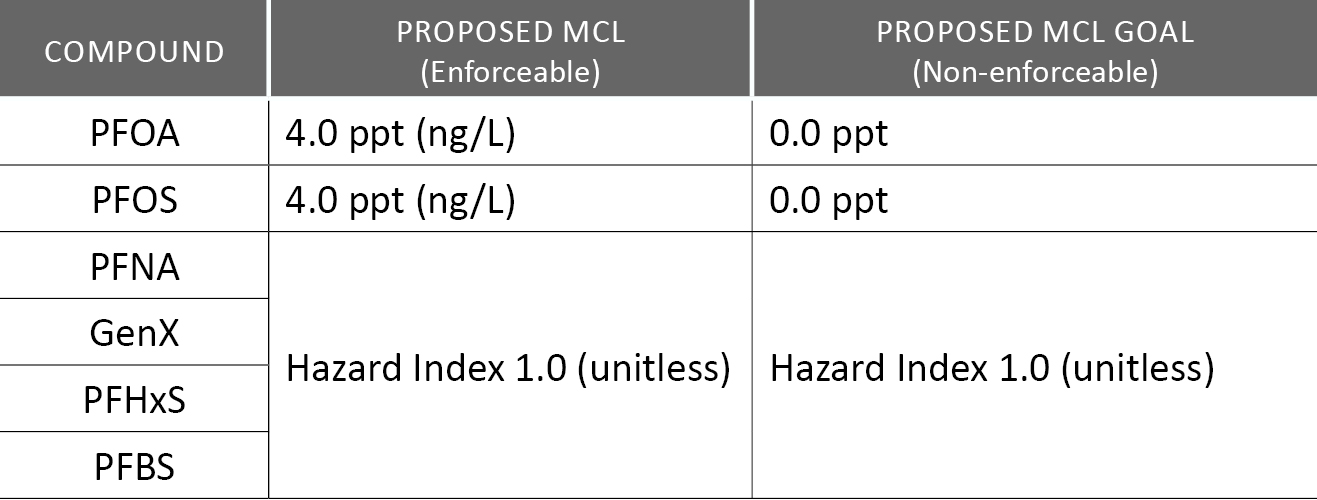Legal Limbo: How Low Can We Go? EPA Proposes National PFAS Limits in Drinking Water at Very Low Levels
Alerts
March 21, 2023
On March 14, 2023, the U.S. Environmental Protection Agency (EPA) proposed what may be considered the most significant National Primary Drinking Water Regulation (NPDWR) to date pertaining to per- and poly-fluoroalkyl substances (PFAS) in drinking water, which will have a ripple effect across the regulated community and business transactions nationwide. As authorized by the Safe Drinking Water Act (SDWA), the EPA proposed the following maximum contaminant levels (MCLs) and MCL Goals (MCLGs) for six PFAS compounds.

For those who may not have seen the movie Dark Waters (or the seemingly daily headlines), PFAS are a class of thousands of “emerging contaminants” used in various manufacturing operations, firefighting foam, food packaging, textiles, cosmetics and many other products. Known as “forever chemicals” because of their resistance to breaking down in the environment, PFAS present potential health risks and have been found in many drinking water supplies.
The proposed individual MCLs for PFOA and PFOS are 4 parts per trillion (ppt). This is currently the lowest concentration at which labs can (somewhat) reliably measure PFOA and PFOS in drinking water. The proposed aspirational MCLGs for PFOA and PFOS are zero, as EPA maintains there is no “safe” level of consumption. For reference, according to the CDC, the general population has average blood PFAS levels in the single digits parts per billion (ppb), which is three orders of magnitude greater than ppt.
Under the SDWA, MCLs apply to “public water systems” that serve at least 25 people or have 15 or more service connections, including many businesses, schools and other facilities in suburban and rural communities serviced by wells. Importantly, the SDWA does not apply to private residential drinking water wells, which are not public water systems.
The proposed rule would require a public water system to sample for six PFAS compounds and notify the public of their respective levels. If an MCL is exceeded, then certain response actions would be required (e.g., installing filtration or treatment systems). Relatively few public water systems have sampled for PFAS, so it is difficult to predict how many would be required to take action if the proposed MCLs became effective or how much such action could cost nationally (although it’s safe to assume hundreds of millions of dollars annually).
We note the Infrastructure Investment and Jobs Act (a/k/a the Bipartisan Infrastructure Law) allocated $21 billion to address drinking water issues. This included additional funding to the EPA's Emerging Contaminants in Small or Disadvantaged Communities (EC-SDC) Grant Program, from which Connecticut recently received $18 million to help these communities address PFAS-related drinking water issues. It is not yet clear exactly how and where these funds will be spent.
Additional State Considerations
If the proposed NPDWR becomes effective, then public water systems will need to comply and start taking preparatory actions before the three-year compliance date, as noted below, arrives. Further, states are permitted to promulgate more stringent requirements with lower acceptable levels. While many states have already set their own state-specific drinking water MCLs for certain PFAS, some existing state MCLs are set higher than EPA’s proposed limits. Looking ahead, we expect states to continue enforcing their MCLs and to eventually lower their limits to match (or be more stringent than) EPA’s, perhaps even before EPA’s compliance date takes effect.
What Steps Can be Taken Now?
The proposed rule is subject to a 60-day public comment period once published in the Federal Register and EPA will hold a public hearing on May 4, 2023. If approved and once effective, public water systems will have three years to achieve compliance. This is a tight timeline for public water systems to evaluate options and implement corrective actions.
To jumpstart this effort, owners and operators of public water systems should develop a risk management plan specific to their operations (including the water source) and potential PFAS-related issues and liabilities (e.g., compliance gaps, third party claims). In addition, it is critical for real estate and manufacturing owners and buyers (and their investors) to evaluate their drinking water source(s) and the potential risks related to PFAS generally and with respect to the proposed PFAS MCLs specifically. In light of the evolving state and federal PFAS legal framework and the ever-increasing threat of PFAS-related litigation, any internal risk assessment should be carefully conducted through in-house or external legal counsel and coordinated with experienced environmental consultants.
If you have questions about PFAS, please contact a Shipman environmental lawyer for more information. Our team is advising national clients in various real estate, manufacturing, agricultural and other sectors on the potential legal and technical impacts of PFAS on their operations and/or transactions and evaluating and implementing PFAS-related risk management strategies.
Related Industries
- Manufacturing
- Independent Schools
- Education
